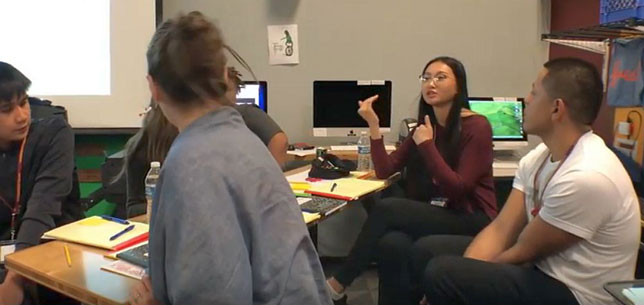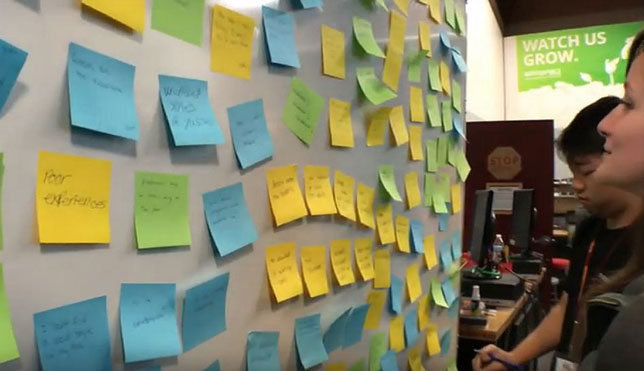Building Career Skills in the Campus Makerspace
California's community colleges are piloting a new approach to student internships that marries team-based projects with hands-on work in makerspaces.
- By Dian Schaffhauser
- 09/04/19
The challenge with most student internships is the investment of effort and time required to set them up. Each student must be paired with an employer and jump through countless administrative hoops before starting work.
But in a recent pilot, a handful of California community colleges tested a new format that has all the benefits of traditional internships — students can gain insight on prospective careers, develop soft skills and practice working on real-world problems — in a team-based structure that's far more scalable and sustainable. And the organizers behind the project have produced free guides to help other colleges emulate the new model.
So what's the catch? The approach works best when there's a makerspace on campus — and frankly, it takes money to keep those gears turning.
Problems with Internships
Makermatic, the name of the team internship program launched by the California Community Colleges (CCC), was intended to solve the main problems the schools were seeing in the field as they helped students set up work experiences.
The first was scalability, said Salomon Davila, a technical assistant provider, who along with Deborah Bird, managed the pilot for CCC. "Pairing up a student with an employer takes a lot of time and energy."
That includes helping students prepare, engaging employers to accept students and then identifying the right combination of worker and placement. On top of that, many of the CCC internships already in place required the costly help of faculty members to do the grunt work involved in site visits, employer communication and student evaluation.
Additionally, there's the barrier of Workers' Compensation. Employers don't want to pay for it for their interns, so the college system "took that issue off the table" by covering it, Davila explained. Likewise, onboarding of students is an uneven process that varies wildly, depending on the availability of HR resources within the given organization working with the intern.
Another biggie is that the students who excel in internships are often the ones who least need the experience: They already know how to go out and find an internship. They're frequently "self-selected," said Davila. Yet, in an open access school setting, he pointed out, "we are really serving a large population with a variety of skill sets, with a variety of backgrounds, from different ethnicities, age groups [and] life experiences. To limit the experience to just a few select students [presents] equity issues."
Finally, there's the problem of persuading employers to take on what some would consider the burden of working with a student in the first place. Too often, said Davila, schools rely on the "deficit-based" model: "Why do this? Because it's good for our students and good for our society." While there's nothing wrong with that approach, he noted, it relies too much on the generosity of people. Better to go in, he insisted, with a "value proposition model": "Look. We're going to help you with your business and this is how."
The Team Internship Model
Makermatic knocks those obstacles over by taking a dramatically different approach to internships. Instead of the student going off to work in the employer's environment, the organization that needs help comes to the students. And it's not a single intern; it's a whole group — 20 students — primed and prepared to tackle a major business challenge. Mentoring and oversight are provided by college-trained coaches and assistant coaches.

In the course of seven sessions running a total of 20 hours over three weeks, those students follow a prescribed pathway that engages them in a project-based learning experience in which they practice understanding the business problem, performing "ideation" and identifying a solution. Eventually, they divide into smaller, competitive teams to develop solutions to the problem. A few examples of the business challenges tackled: The California State Fair board wanted to increase attendance to the state fair; a regional beer and wine maker wanted to know how to bring in more first-time customers to its rural location; and an architectural firm wanted the student perspective on how to design a 21st century learning environment for a community college.
By the final session, the student teams are ready to make 10-minute presentations to the business leaders, in which they recap the problem, explain their solution and make final recommendations. A panel of other business professionals serve as reviewers, assessing each intern's performance during the presentation in four areas: professionalism, oral communication, teamwork and decision-making.

Another twist is this: Students are paid as student workers; they don't undertake the internship for credit. Too often, Davila explained, "offering another unit for internships is contrary to what the needs of the students are" — essentially becoming what he calls "empty calorie courses." "Many of our community college students are homeless [and] have difficulty finding food, and transportation is always an issue." Besides, he added, "With the unit cap that the federal financial aid system puts on them, it doesn't really help students to have extra units on their transcript if they don't need it, because they run out of financial aid quickly."
The Makerspace Connection
Davila believes that by tying internships to the college makerspace, both benefit: The tools, technologies and the community approach of makerspaces are a happy marriage with the skill development and vocational opportunities of internships.
The challenge for makerspaces in colleges has traditionally been that they're often hosted by a specific discipline or department, he noted. Even if the entire campus community is invited to use the makerspace services, CCC has found that the facilities that do the best are those act as a "horizontal service" and are located in a "neutral space," akin to the campus library. Surveying revealed that many of the Makermatic interns had never been in their campus makerspace prior to taking part in the program; by hosting Makermatic through the makerspaces, the colleges were able to expand students' engagement with campus services.
One caveat: The act of prototyping a business solution doesn't really fit into the 20-hour constraint of the Makermatic program. So while prototyping is not a part of the formal structure — the program does indicate that by session five of the seven sessions, if a physical prototype needs to be developed and tested, then session five is to be extended to as many days as needed.
Davila added that if the employer picks a solution or combination of solutions that calls for the creation of a physical object, that part of the job can be handled after the team internship is over, either through an additional internship or the hiring of students, who can do the work in the makerspace.
Outcomes
By the time two pilots were done (one in fall 2018 and another in spring 2019), 120 interns reflecting 17 disciplines had worked with six business partners. Interns gave high marks for Makermatic exposing them to career options (especially when compared to the confidence they indicated in their career selections). They also rated the program positively in terms of helping them learn how to develop solutions, share ideas, communicate, solve problems, collaborate, settle on a course of study and plan solutions.
The only negative measure was in the area of developing a small business. As Davila explained, "They go in thinking, 'Yeah. I can build a small business.' They come out understanding what it takes to build a business, and they're like, 'Oh, wait a minute. I can't do that.'"
The businesses that participated where more circumspect. While most acknowledged the appeal of gaining outside perspective and having multiple minds looking at a challenge, results were uneven. As one company noted, "Some of their ideas were good and some were not cost-effective or scalable. There are aspects of the business environment they didn't understand." And yet, in the end even that business adopted one of the solutions proposed and hired two of the interns. In fact, three of the companies ended up hiring interns for additional work, according to Davila. And most said they'd participate in Makermatic again if it were repeated.
What's Next
Funding has run out for the Makermatic project, so fans of the program are on the hunt for additional support. That could come from the Chancellor's Office or through a grant from the National Science Foundation. Davila doesn't know yet: "Right now, we're in a holding pattern to see who may be interested in taking it on," he said.
The six colleges that were part of the pilot project want to continue the program, and Davila has received inquiries from an additional institution that's interested in being included. One original test pilot — Cabrillo College in Santa Cruz — has scaled up its commitment by developing a campaign for soliciting funds through the college's foundation. Employers provide funding to the foundation as a gift, and in return, those funds are being plowed into paid internships offered as scholarships. Cabrillo has contracted with Goodwill Industries Central Coast to onboard the interns as part of its "Strong Workforce" program, using the Makermatic structure as the model.
Davila is upbeat about the future. "Change is hard for the sort of institutions that we're talking about here and so they pace themselves," he said. "I'm sure [Makermatic] will have legs in some form. We feel as if this has really transformed the way we approach makerspaces and internships." Or, as a video about Makermatic concluded, "As a result of this process, business leaders had the opportunity to select or combine solutions to their business challenge [and] students were able to connect to the challenge and meet business leaders and entrepreneurs in their community — ultimately impacting their path and education and future career goals."
About the Author
Dian Schaffhauser is a former senior contributing editor for 1105 Media's education publications THE Journal, Campus Technology and Spaces4Learning.